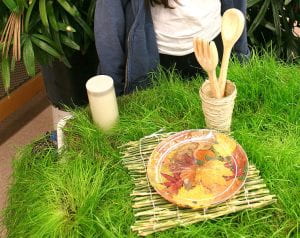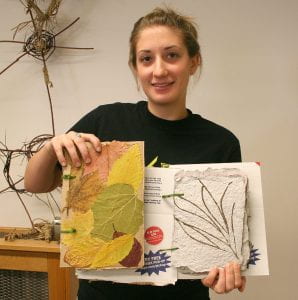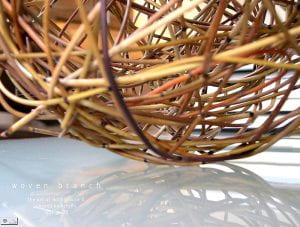Introduction
Mat Weaving
Rope Making
Net Knotting
Paper Making
Indigo Dyeing
Educator Resources
Learning Standards
Introduction
What do mats, rope, indigo, paper, and nets all have in common?
All are related to textiles and all are made from plants, of course!
This project focuses on past and present technologies that convert plant materials into fibrous products. If you are wearing blue jeans, you likely are wearing indigo – a time-honored plant dye. You can still purchase handmade paper, even though most of today’s paper comes from large mills. Rope, nets, and mats, once made by hand from plants, are now manufactured in factories using a variety of raw materials.
And each activity consists of four main components:
• Tools – make a tool.
• Technology – use the tool in a traditional activity.
• Research – use the Internet to learn about comparable technologies and products in today’s market, and to further explore plant fibers and textiles.
• Connections – involve others from your community.
The activities vary in their level of difficulty and the amount of time and materials required. Below the activities are listed according to these factors, along with a short activity summary for each:
Mat Weaving (quick and easy):
In this activity, youth will understand the basic functions of a loom and will weave a simple mat. Weaving is said to be the most ancient of the arts. Some say humans mimicked the intricate nests of the weaver-bird or the graceful patterns of a spider web. Others credit the combination of human ingenuity and needs. Whatever its origin, textile production is so essential that it has a significant presence in our language, customs, and literature.
Introduction (pdf)
Tools(pdf)
Technique(pdf)
Research(pdf)
Expanding the Activity(pdf)
Learning Standards for Mat Weaving(pdf)
Rope Making (quick and easy):
In this activity, youth will learn about rope structure and will create natural fiber-based ropes! No one knows when the first rope was made. We do know that sailors, builders, hunters, and farmers have long depended on rope to move and control animals, structures, and machines. Early ropes were made by hand, using cotton, dogbane, sisal, jute, hemp, flax, abaca (manila hemp), coir (coconut husks), leather, or hair. Today, most ropes are made in factories from petroleum-based synthetic fibers.
Introduction (pdf)
Tools(pdf)
Technique(pdf)
Research(pdf)
Expanding the Project(pdf)
Learning Standards for Rope Making(pdf)
Net Knotting (moderately easy):
In this activity, youth will get a chance to understand net structure by making knots and differently shaped nets. Nets have been used for thousands of years to trap, carry, protect, and store items. Today, netting structures are found in hammocks, basketball nets, insect traps, tennis nets, plant hangers, shopping bags, belts, clothing, hockey/soccer goals, etc.
Introduction (pdf)
Tools(pdf)
Technique(pdf)
Research(pdf)
Learning Standards for Net Knotting(pdf)
Paper Making (preparation needed; a little messy):
 In this activity, youth will collect fibrous plant materials and create handmade paper.
In this activity, youth will collect fibrous plant materials and create handmade paper.
Papermaking was invented in China, but was a well-kept secret for hundreds of years until 700 AD when Arabs captured an entire village of Chinese paper makers! Over the centuries and across cultures, the art of papermaking developed into a variety of traditions. These traditions continue today, with both mills and artists researching ancient techniques, new technology, and different plant fibers.
Introduction (pdf)
Tools(pdf)
Technique(pdf)
Research(pdf)
Expanding the Activity(pdf)
Learning Standards for Paper Making(pdf)
Indigo Dyeing (preparation needed; material intensive):
 This activity gives youth the opportunity to practice and learn the various techniques used in the process of Indigo Dyeing. They will learn about both traditional and modern technologies, history, and science of dyes made from plants.
This activity gives youth the opportunity to practice and learn the various techniques used in the process of Indigo Dyeing. They will learn about both traditional and modern technologies, history, and science of dyes made from plants.
Introduction (pdf)
Tools(pdf)
Technique(pdf)
Research(pdf)
Expanding the Activity(pdf)
Learning Standards for Indigo Dyeing(pdf)
Educator Resources
I. Adapting the Activities to Your Educational Setting (pdf)- Read how others are using this curriculum in both formal and informal educational settings
II. Make Your Own Toolkit (pdf)– Learn how to assemble your own project toolkit.
III. Showcase (pdf)– Find out how you can showcase your work in your community.
Learning Standards
New York State Learning Standards
Each of the activities featured on this site are aligned to the New York Academy of Teaching and Learning (NYSATL) standards for Mathematics, Science and Technology.
The learning standards detail the following for each activity:
• Chapter Heading
• Standard Area
• Number
• Level
• Subject
• Performance Indicators
Table Key:
MST = Mathematics, Science and Technology
E = Elementary (Grades K-4)
I = Intermediate (Grades 5-8)
C = Commencement (Grades 9-12)
* Elementary standards were not evaluated since the target audience for the activities was Grades 5-12.
Click on each of the activities below for their learning standards (pdfs):
• Indigo Dyeing Learning Standards
• Mat Weaving Learning Standards
• Paper Making Learning Standards
• Rope Making Learning Standards
• Net Knotting Learning Standards



